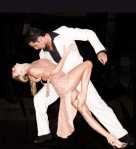Ballroom dance refers collectively to a set of partner dances, which originated in the Western World and are now enjoyed both socially and competitively around the globe. Its performance and entertainment aspects are also widely enjoyed on stage, in film, and on television.
While historically ballroom dance may refer to any form of formal social dancing as recreation, with the eminence of dancesport in modern times the term has become much narrower in scope, usually referring specifically to the International Standard and International Latin style dances (see dance categories below). In the United States, two additional variations—”American Smooth” and “American Rhythm”—have also been popularized and are commonly recognized as styles of “ballroom dance”.
Dances
In one common usage “ballroom dance” refers to the ten dances of International Standard and International Latin, though the term is also often used interchangeably with the five International Standard dances In the United States, the American Style (American Smooth and American Rhythm) also exists. The dance technique used for both International and American styles is identical, but International Standard allows only closed dance positions, whereas American Smooth allows closed, open and separated dance movements. In addition, different sets of dance patterns are usually taught for the two styles. International Latin and American Rhythm have different styling, and have different dance patterns in their respective syllabi.
Others dances sometimes placed under the umbrella “ballroom dance” include Nightclub Dances such as Lindy Hop, West Coast Swing, Nightclub Two Step, Hustle, Salsa, and Merengue. The categorization of dances as “ballroom dances” has always been fluid, with new dances or folk dances being added to/removed from to the ballroom repertoire from time to time, so no list of subcategories or dances is any more than a description of current practices. There are other dances historically accepted as ballroom dances, and are revived via the Vintage dance movement.
In Europe, Latin Swing dances include Argentine Tango, Mambo, Lindy Hop, Swing Boogie (sometimes also known as Nostalgic Boogie), and Disco Fox. One example of this is the subcategory of Cajun dances that originated in New Orleans, with branches reaching both coasts of the United States.
Standard/Smooth dances are normally danced to Western music (often from the mid-twentieth century), and couples dance counter-clockwise around a rectangular floor following the line of dance. In competitions, competitors are costumed as would be appropriate for a white tie affair, with full gowns for the ladies and bow tie and tail coats for the men; though in American Smooth it is now conventional for the men to abandon the tailsuit in favor of shorter tuxedos, vests, and other creative outfits.
Latin/Rhythm dances are commonly danced to contemporary Latin American music, and with the exception of a few traveling dances (e.g. Samba and Paso Doble) couples do not follow the line of dance and perform their routines more or less in one spot. In competitions, the women are often dressed in short-skirted latin outfits while the men outfitted in tight-fitting shirts and pants; the goal being to bring emphasis to the dancers’ leg action and body movements.
 [For further explanations and the history of certain styles see additional pages listed on the side bar]
[For further explanations and the history of certain styles see additional pages listed on the side bar]
International Style
- International Standard
- Slow Waltz – Tango – Viennese Waltz – Slow Foxtrot – Quickstep
American Style
- American Smooth
- Waltz – Tango – Foxtrot – Viennese Waltz
- American Rhythm
- Cha Cha – Rumba – East Coast Swing – Bolero – Mambo
Historical/Vintage Dance
- Waltz – Polka – Schottische – Tango – One-Step – Foxtrot – Peabody
Other dances occasionally categorized as ballroom
- Nightclub
- Nightclub Two-step – Hustle – Modern Jive / LeRoc / Ceroc – and the whole swing variety: West Coast Swing / East Coast Swing (always included in the “Rhythm-Swing” category) / Carolina Shag / Collegiate Shag
- Latin nightclub
- Salsa – Merengue – Cumbia – Bachata – Cha cha
- Brazilian Dances
- Forró – Pagode – Samba de Gafieira – Lambada
- Country/Western
- Polka – Cha-cha-cha – Two-step – Waltz…
- also referred to as “Country and Western” or C/W:
- C/W Polka – C/W Cha-cha – C/W Two-step – C/W Waltz…
- Cajun dances
- Cajun One Step or Cajun Jig – Cajun Two Step – Zydeco – Cajun Waltz – Cajun Jitterbug
- Musette dances
- Java, musette-waltz, musette-tango, musette-paso-doble.
- Other
- Argentine tango
